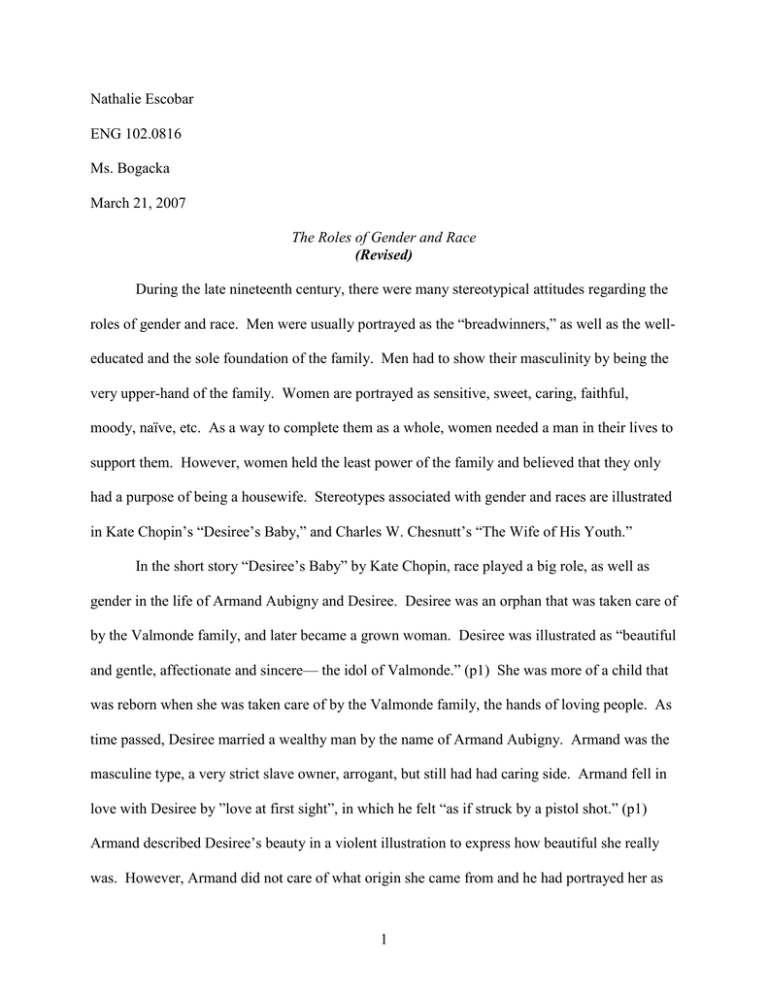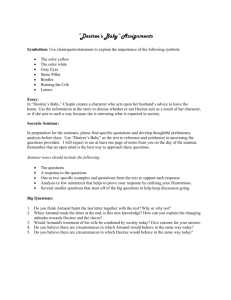Nathalie Escobar ENG 102.0816 Ms. Bogacka March 21, 2007
advertisement

Nathalie Escobar ENG 102.0816 Ms. Bogacka March 21, 2007 The Roles of Gender and Race (Revised) During the late nineteenth century, there were many stereotypical attitudes regarding the roles of gender and race. Men were usually portrayed as the “breadwinners,” as well as the welleducated and the sole foundation of the family. Men had to show their masculinity by being the very upper-hand of the family. Women are portrayed as sensitive, sweet, caring, faithful, moody, naïve, etc. As a way to complete them as a whole, women needed a man in their lives to support them. However, women held the least power of the family and believed that they only had a purpose of being a housewife. Stereotypes associated with gender and races are illustrated in Kate Chopin’s “Desiree’s Baby,” and Charles W. Chesnutt’s “The Wife of His Youth.” In the short story “Desiree’s Baby” by Kate Chopin, race played a big role, as well as gender in the life of Armand Aubigny and Desiree. Desiree was an orphan that was taken care of by the Valmonde family, and later became a grown woman. Desiree was illustrated as “beautiful and gentle, affectionate and sincere— the idol of Valmonde.” (p1) She was more of a child that was reborn when she was taken care of by the Valmonde family, the hands of loving people. As time passed, Desiree married a wealthy man by the name of Armand Aubigny. Armand was the masculine type, a very strict slave owner, arrogant, but still had had caring side. Armand fell in love with Desiree by ”love at first sight”, in which he felt “as if struck by a pistol shot.” (p1) Armand described Desiree’s beauty in a violent illustration to express how beautiful she really was. However, Armand did not care of what origin she came from and he had portrayed her as 1 “nameless,” as if Desiree was some kind of possession (p1). Later when Desiree had a child, she had thought to bring the family closer with love, had brought nothing but consequences to the family. The love that Desiree and Armand shared had turned against her as she faces racial discrimination from her own husband. At first, Armand was happy in having a son to carry his family name, but when he closely looked at the color of the child’s skin, he immediately rejected Desiree and the child. Armand, as a slave owner, felt it would be a disgrace to his family’s name and to the people if they were to find out he was to have a colored child of his own. In addition, others would look at him differently because the fact that he treats his slaves very cruel would be injustice while he has a child of the same origin. During the whole marriage, Desiree finally ends in a downfall where she leaves and takes the baby with her, and leaves a message that consists of the truth about Armand’s mother. As Desiree sadly leaves him, she goes into a deep depression and leads herself with the baby into a deserted path into the woods. After Desiree left, Armand finds out from reading the letter, “…Armand will never know that his mother, who adores him, belongs to the race that is cursed with the brand of slavery” (p4). In “The Wife of His Youth” by Charles W. Chesnutt, there were many stereotypical views on race and gender in the lives of Mr. Ryder and Eliza Jane. In the nineteenth century, every man’s goal was to be successful and the “breadwinner” of the family. However, not every man had the chance to start out big, for Mr. Ryder, he started as Sam Taylor. Sam Taylor was a freeborn slave, where he worked in a plantation as an apprentice and had no source of education. Eventually, the plantation owner wanted to sell him for more money as a slave, but Sam Taylor didn’t want to live the life of a slave. Therefore, he fled the plantation and leaving a slave marriage with Eliza Jane for a better life. Sam Taylor than educated himself slowly, improved his image and changed his name as Mr. Ryder. Mr. Ryder was portrayed a very wealthy man, a 2 freeborn, highly educated man, etc. He was like every woman’s dream of a successful man to be. Mr. Ryder had most of the traits of a man like masculinity and leadership. However, what stopped him from being equal in society was the color of his skin, even though he was a lightcolored African American. The only way to be equal in society; he joined an organization called “The Blue Veins” that was exclusively for light toned members and of wealth. Eliza Jane, in the other hand was illustrated as “She wore a blue calico gown of ancient cut, a little red shawl fastened around her shoulders with an old-fashioned brass brooch, and a large bonnet profusely ornamented with faded red and yellow artificial flowers…She looked like a bit of the old plantation life…” Eliza Jane was described as a woman of a southern plantation life because all her life, she was a slave that cooked for a family and was barely educated. She seemed like the typical woman that is naïve, sweet, loyal, etc. She showed loyalty because for twenty-five years she was searching for her long lost husband, but too naïve to notice that Mr. Ryder was her husband. However, Mr. Ryder had faced a racial dilemma for choosing the woman he wanted to marry. In order to feel like he would be accepted in society, he proposed a story in a ball which was based unknowingly about his life to the members of his society. He wanted to see if his members were racist against the fact that the individual, was to be happily with the colored woman. However, the close members of his society agreed to Mr. Ryder that “he should acknowledge her.” As Mr. Ryder, he felt that he had more choices in his life because he was the dean of “The Blue Veins” society and was wealthy. He was also easily acknowledged in society because of his social status and of his skin. He was a well respected man, had a good life in which he was able to supports himself, and a “ladies man.” Mr. Ryder had better opportunities and a future than the life of Sam Taylor. Sam Taylor was more of a freeborn slave, but still was 3 treated as a slave and had no other choices but to run away. As a result, he fled to avoid being sold as a slave, he had to start a new life and change his name as a way not to be caught. During the late nineteenth century, there were many stereotypical attitudes regarding the roles of gender and race which was described in both “Desiree’s Baby” and “The Wife of His Youth.” However, stereotypes still continue on through the years as society slowly became modernized. Gender and racial stereotypes still exist until today, but multicultural values became more expanded through all colors like religion, foreign traditions, etc. However, many people still strongly believe the views of women and men in society of the nineteenth century. Some of its tradition still exists, of the man as the “breadwinners” and the wives as housewives, but now women in society have the rights to vote and have the rights for employment. Even if society may change through the centuries, the general concept of the man is the sole foundation of the family and the wife being supported, still exists within many relationships and the values of other cultures. 4







